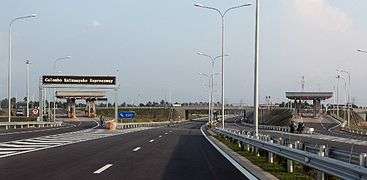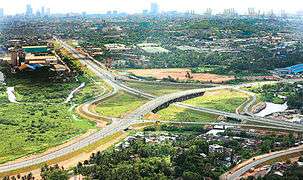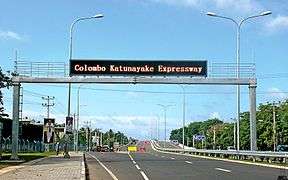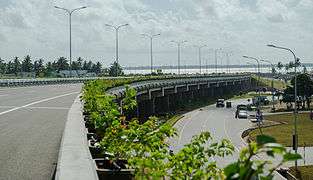E03 expressway (Sri Lanka)
| |
|---|---|
| Airport Expressway | |
 | |
| Route information | |
| Maintained by the Road Development Authority | |
| Length: | 25.8 km[1] (16.0 mi) |
| Existed: | 27 October 2013 – present |
| History: | Opened on 27 October 2013 |
| Major junctions | |
| North end: | Bandaranaike International Airport and Negombo city |
|
Interchange 4 → Ja-Ela Interchange 3 → Kerawalapitiya (Under-construction) - connect with E02 Colombo Outer Circular Expressway Interchange 2 → Peliyagoda Interchange 1 → Wattala | |
| South end: | New Kelani Bridge and Colombo city |
| Highway system | |
| Expressways of Sri Lanka | |
Colombo - Katunayake Expressway E03 is Sri Lanka's second E Class highway.[1] The 25.8-kilometre-long (16.0 mi) highway links the Sri Lankan capital Colombo with Bandaranaike International Airport, Katunayake[2] and Negombo city. Construction on the highway began in October 2009, and it was opened on the 27th October 2013, by former president Mahinda Rajapaksa.[3] The highway has three lanes each way from Colombo to Peliyagoda, and two lanes each way from Peliyagoda to Katunayake, with the width ranging from 26 to 33.5 metres (85 to 110 ft).[4]
The total cost of the project is US $292 million. Exim Bank of China funded US$248.2 million of the total cost and the government of Sri Lanka spent US$45 million on the project.[5]
The speed limit is 80 km/h (50 mph) for the first eight kilometres (5.0 mi) and 100 km/h (62 mph) for the rest of the road.[1] The Expressway has 42 bridges and 88 culverts including a 480 metre long viaduct at Hunupitiya and an 800-metre viaduct at Katunayake.[6] The opening of the highway has allowed people to travel between Colombo, the commercial capital of Sri Lanka and Katunayake, the major international airport of Sri Lanka, within 15 minutes.
The E03 expressway links the capital Colombo with one of the major commercial hubs in the country and the major tourist destination Negombo city, within 20 minutes. Sri Lanka Transport Board (SLTB) has also commenced a luxury bus service on the road, conducting services between Colombo - Negombo.
History
The contract was awarded to China Metallurgical Group Corporation (MCC) by the Government of Sri Lanka and the agreement was signed on 17 August 2008. The project loan agreements were signed on 6 August 2009 and the construction commenced on 18 August 2009.[6] The expressway was opened on the 27th October 2013 by President Mahinda Rajapaksa.[3]
Interchanges
- New Kelani Bridge Interchange
- Peliyagoda Interchange
- Kerawalapitiya Interchange (under-construction) (connect with E02 Colombo Outer Circular Expressway)
- Ja-Ela Interchange
- Katunayake Interchange[1]
Toll Structure
The portion between New Kelani Bridge entrance (entry point from the City of Colombo) and Peliyagoda interchange is toll-free. Only the portion beyond Peliyagoda is operating as a toll road. Toll is to be paid at the Negombo toll-plaza when travelling direct from Peliyagoda, or when exiting at any toll-station mid-way.
ETC (Electronic toll collection) systems installed at all interchanges along the expressway.
- Electronic Toll Collection (ETC) payment facility is available in all Toll Gates in Colombo-Katunayake Expressway.
- ETC card will be issued at Customer Care Center located at Peliyagoda near to the Thorana Junction in Colombo-Kandy Road (A1).
- Payment for the ETC shall be done by recharging an ETC account opened in Bank of Ceylon by any means such as cash, direct debit or e-banking.[7]
For more information click here

Small Vehicles
- Peliyagoda - Ja-Ela - LKR 200
- Ja-Ela - Katunayake - LKR 200
- Peliyagoda - Katunayake - LKR 300
Large Vehicles
- Peliyagoda - Ja-Ela - LKR 300
- Ja-Ela - Katunayake - LKR 300
- Peliyagoda - Katunayake - LKR 600
Bus fares of the Private luxury service
- Colombo - Katunayake - LKR 120 (Route No. 187 E-03)
- Colombo - Negombo - LKR 120 (Route No. 240 E-03)
Bus fares of the SLTB super luxury service
- Colombo - Katunayake - LKR 120 (Route No. 187 E-03)
- Colombo - Negombo - LKR 120 (Route No. 240 E-03)
Gallery
 Katunayake Expressway (E03)
Katunayake Expressway (E03) Birds-Eye Shot of CKE
Birds-Eye Shot of CKE CKE at night
CKE at night CKE
CKE Colombo Katunayake Expressway declared open
Colombo Katunayake Expressway declared open Display Sign on CKE
Display Sign on CKE Electronic Display Sign - CKE
Electronic Display Sign - CKE A road sign
A road sign Elevated section of the CKE
Elevated section of the CKE- CKE under construction in 2012.
See also
-
 Roads portal
Roads portal -
 Sri Lanka portal
Sri Lanka portal - List of A-Grade highways in Sri Lanka
References
- 1 2 3 4 "The Salient Features of Colombo-Katunayake Expressway". Road Development Authority. Retrieved 2013-10-21.
- ↑ "VIDEO: President inspects Colombo-Katunayake expressway". Adaderana.lk. 2012-08-16. Retrieved 2012-10-22.
- 1 2 "Colombo-Katunayake Expressway declared open". Ministry of Defence and Urban Development. 2013-10-27. Retrieved 2013-10-27.
- ↑ "Features | Sundayobserver.lk - Sri Lanka". Sundayobserver.lk. 2012-06-24. Retrieved 2012-10-22.
- ↑ "Sri Lanka News | Online edition of Daily News - Lakehouse Newspapers". Dailynews.lk. 2012-07-11. Retrieved 2012-10-22.
- 1 2 http://www.dailynews.lk/2013/03/16/news14.asp
- ↑ "Expressway Operation Maintenance And Management Division Road Development Authority - Sri Lanka". exway. Retrieved 4 May 2016.
External links
| Wikimedia Commons has media related to Colombo-Katunayake Expressway. |
